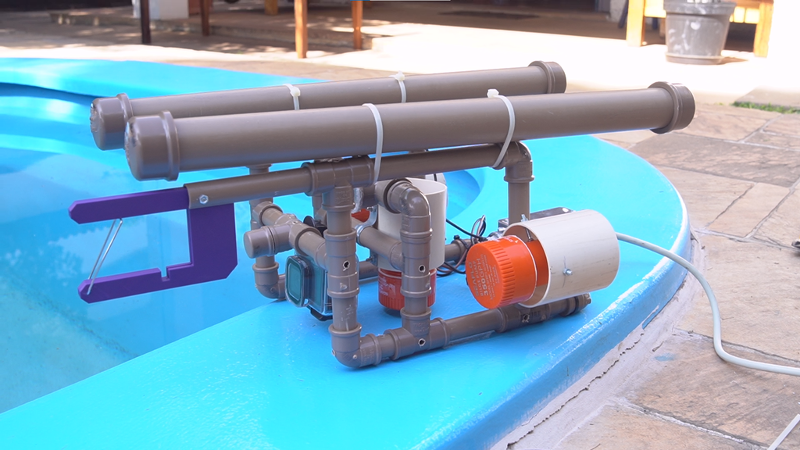We doubt you could really live in [Pena’s] PVC submarine, but now the song’s stuck in our head anyway. Although the post is in Portuguese, you can get a pretty good idea of how it works, and translation software is better than ever. Transcending the language barrier, there are videos of just about every step of the construction. We didn’t, however, find a video of the vehicle in the water.
The plumber’s delight has modified motors for thrusters, and a camera as well. Epoxy potting keeps things waterproof. We’ve seen candle wax used for the same purpose in other builds.
Our Portuguese may be wanting, but we couldn’t figure out how the sub worked with ballast or any other scheme to change its buoyancy dynamically. There was talk of using PVC tubes that hold air and trimming them to get neutral buoyancy, but there seemed to be no way to change it on the fly, so to speak. Perhaps someone with better language skills can help us out in the comments. We did note that the tether cables had an interesting buoyancy measure: pool floats cut open to make floating conduits. Not a bad idea.
We’ve seen PVC subs before and they can be surprisingly inexpensive. We’ve also used baking powder for buoyancy.
















This sub only goes to a depth of 10 meters and does not seem to rely on buoyancy controls of any sort. It uses a central motor (vertically aligned) to control the depth. The two long rods on the top sides are only there to help keep the whole sub level (by manually moving them to the front/back) and kind of keep it floating when not submerged.
The vertical motor can be seen at https://www.youtube.com/watch?v=4iq41D0RaVQ around 1:00.
You are right about the motor. Around 14:10 they show this drone in open water https://youtu.be/Bs6Kca6n420. They also made a sub with buoyancy for one person. It was a long project but the results you can check here https://youtu.be/qNTzx1p_MzQ.
I’d rather live in a PVC “Sealab”, though I’d need a PVC or other submarine to commute to the surface
“Sealab 2021”
-Adult Swim
I was thinking more like when Jacques Cousteau, and the US Navy, had undersea dwellings. And there was Sealab 2020, which wasn’t a joke.
IIRC, one of those undersea dwellings still required compression/ decompression to journey back to the surface. And then there was the problems of excess humidity, venting odors, safe electricity, and having the dolphins watching your every move through those giant windows. B^)
The sub that DIY perks made is pretty cool: https://youtu.be/pUba126uzvU
You mean https://hackaday.com/2021/12/10/build-your-own-submarine/
Oops, posted in the wrong place.
The entire PVC frame has holes al over to allow water to fill the frame. The only sealed bits are for where the electrical connections are made.
To provide enough buoyancy, the 2 50mm PVC pipes on top are left filled with air and the builder needs to use trial and error to cut them down to a size that just keeps the entire thing neutrally buoyant.
Scientific dissemination channel through Brazilian DIY projects (Approximately 12 million subscribers), have already built several submarine projects (including one that transported 1 human up to 10 meters deep) and similar ones such as a submarine drone and this one made of PVC.
It’s a kind of celebration, every year-end on the canal (Building a boat or submarine).
Now they will join a medium-sized rocket (likely over 30 km, the type that will need launch authorization)
The “Activity Maker” is also part of the Channel, with the aim of teaching projects using Arduino or basic electronics.
As for the submarine design, yes it had mobile ballast in addition to the fixed one (lead) and could sink or submerge itself using tanks.
https://www.youtube.com/watch?v=qNTzx1p_MzQ